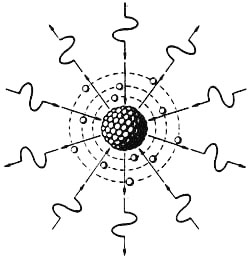|
SCALAR EM WAVES ARE EMITTED AND ABSORBED BY THE NUCLEUS. SLIDE 27
Normally scalar EM waves do not couple to orbital electrons. Entering into the atom, incoming scalar EM waves penetrate the electron shells without interaction. They continue, penetrating into the interior of the closely packed nucleus, where the extreme nonlinearity of the charged virtual particle flux that binds the nucleons together distorts the scalar wave, dephasing its summed EM vector components. This produces a nonzero EM resultant and polarized pattern directly inside the virtual particle charge flux of the nucleus. The new EM resultant immediately couples the distorted scalar wave to the nucleus, resulting in absorption of the wave and incorporation of its polarization pattern into the nucleus’ virtual flux. This in turn results in a slightly excited nucleus. Normally the excited nucleus will promptly decay by emitting another scalar wave, which passes through the orbital electron shells and radiates out into the universe. However, as can be seen, if the same strong scalar pattern is constantly radiated into the nucleus and absorbed by it, the excitation of the nucleus "charges up," leading to decay by other modes. In this manner the nucleus can be engineered -- even transmuted -- by rather minuscule power of the engineering radiation signal. This is how living biological systems are able to transmute elements, as discovered by Louis Kervran. (Kervran was nominated for the 1977 Nobel Prize for this work.). The biosystem produces scalar EM waves. If the appropriate signal is employed into and on the appropriate nucleus, a changed element emerges. In this fashion chickens denied sufficient calcium in their diet, but allowed a surplus of potassium, are able to transmute some of the potassium into calcium. Note that one of the isotopes of potassium is an isomer of normal calcium. Transmutation of this potassium isomer to calcium is easiest. |
